|
Horse Owner's Guide For Better Hoof Health
Article from Equina USA - a Veterinarian-Owned Company
One of the most important aspects of equine management and keeping horses healthy and sound is proper hoof care. It starts to matter
very early in life as hoof angles influence the growth and development of the limbs. It is important in the early stages of training as young
horses start developing patterns of movement and musculature under saddle. Proper trimming or shoeing is paramount for mature riding
horses at all levels of all disciplines for maintaining soundness and optimal performance. As a veterinarian, I see many horses for
lameness or poor performance and find that the feet are not optimal. This makes a true diagnosis of the problem difficult, if not
impossible. I see a trend in my profession of injecting joints and treating lameness in the limbs when the feet are not correct. This is not
to say that injections never help, but I prefer to correct the feet first (and to consider nutrition, body work, tack, training), then see if further work on the limbs is needed.
For horse owners, I think it is important to develop a good eye and a general understanding of what the feet should look like. Also, it is
helpful to be aware of signs a horse might show if the feet are problematic. It will allow you to better monitor and care for your horse,
and possibly to raise the bar on goals for how the feet should look and function. I often hear people describe their horse's feet with an
attitude of "that's just how he/she is" when speaking of things like thin soles, underrun heels, etc. That is rarely the case, the hoof is
actually quite malleable and such issues can be solved. I encourage horse owners to really tune in to their horses, to observe their
patterns of behavior and movement, and to realize the power in their own attention to detail.
I would like to suggest some basic guidelines owners can use to more thoroughly understand and assess the form and function of the hooves. Whether a horse is barefoot or shod, there are 3 things to consider:
1. Appearance of the hoof angles and appearance of the hoof itself
2. Stance - how the horse tends to place the feet when standing still
3. How the feet function when the horse is in motion
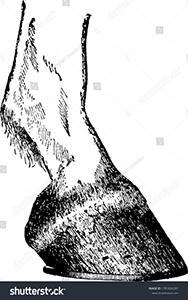 1. The angle of the hoof should flow in alignment with the angle of the pastern. The hoof also affects
the angle of the pastern so it should appear supportive from an architectural perspective. (photo #1
shows a balanced foot ) If you get the impression that the fetlock is dropping back and hanging off a
cliff or rocking forward and knuckling, these could be signs of incorrect angles. The hoof itself should offer an appearance of symmetry. The feet should seem robust with a fair bit of hoof wall between the
hairline and the ground. Hooves should not appear shallow. 1. The angle of the hoof should flow in alignment with the angle of the pastern. The hoof also affects
the angle of the pastern so it should appear supportive from an architectural perspective. (photo #1
shows a balanced foot ) If you get the impression that the fetlock is dropping back and hanging off a
cliff or rocking forward and knuckling, these could be signs of incorrect angles. The hoof itself should offer an appearance of symmetry. The feet should seem robust with a fair bit of hoof wall between the
hairline and the ground. Hooves should not appear shallow.
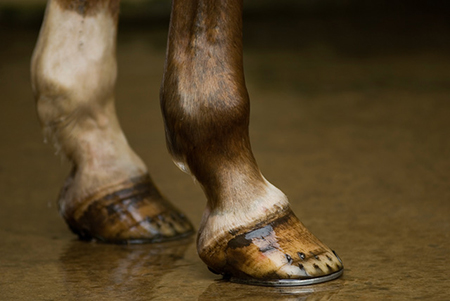 (photo #2 shows shallow hooves with low heels) The hairline should be straight as it wraps around the leg
without bulges or deviations which indicate imbalance and abnormal forces. . The heel bulbs should be of equal size and proportion. The outer (dorsal wall) should form a
fairly straight line without dishing or bulging (bull nose appearance). (photo #2 shows shallow hooves with low heels) The hairline should be straight as it wraps around the leg
without bulges or deviations which indicate imbalance and abnormal forces. . The heel bulbs should be of equal size and proportion. The outer (dorsal wall) should form a
fairly straight line without dishing or bulging (bull nose appearance).
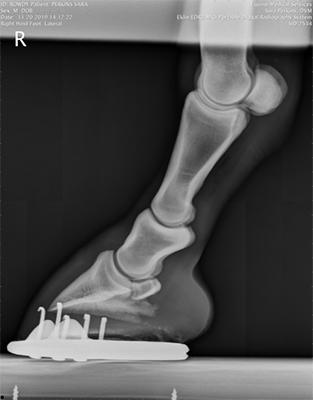 Distortion of the outer wall is a sign of mechanical stress on the hoof, often
caused by an incorrect point of breakover, xrays will often show that the coffin bone and hoof capsule are not lined up for ease of movement.(photo #3 is
xray showing neg coffin bone and bull nose appearance of a hind foot) In general, if you look from the front, the inner half and the outer half of the foot
should be equal in length and shape so that the hoof is not tilted and the walls are symmetrical without flares. Distortion of the outer wall is a sign of mechanical stress on the hoof, often
caused by an incorrect point of breakover, xrays will often show that the coffin bone and hoof capsule are not lined up for ease of movement.(photo #3 is
xray showing neg coffin bone and bull nose appearance of a hind foot) In general, if you look from the front, the inner half and the outer half of the foot
should be equal in length and shape so that the hoof is not tilted and the walls are symmetrical without flares.
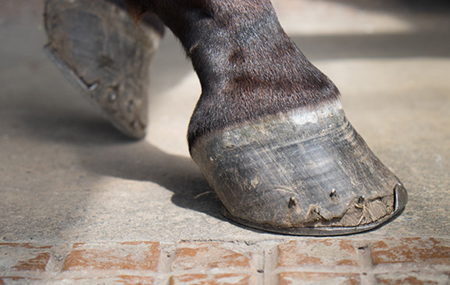 Large cracks in the hoof wall are a sign of stress from
imbalance and a reason to closely examine the trim. Angles of the hind feet are just as important as the fronts. Crumbling/weak hoof walls can be due to gaps in nutrition
and the diet should be reviewed. (Photo #4 shows weak hoof walls, consider nutrition) Large cracks in the hoof wall are a sign of stress from
imbalance and a reason to closely examine the trim. Angles of the hind feet are just as important as the fronts. Crumbling/weak hoof walls can be due to gaps in nutrition
and the diet should be reviewed. (Photo #4 shows weak hoof walls, consider nutrition)
2. Noticing how your horse stands when turned loose or tied up can be useful. In general they should stand fairly square. It is normal to 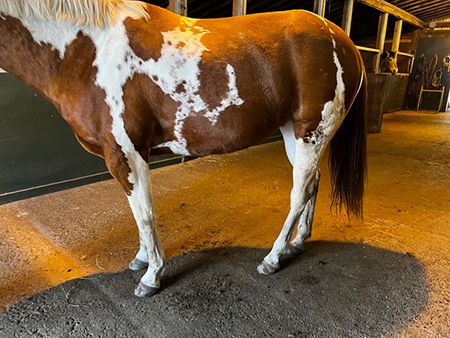 shift weight from side to side to some degree and possibly
cock a hip while at rest. They should not rock back off of the front end or continually point a front foot. They should not continually stand with the forelimbs or hindlimbs camped under the body. shift weight from side to side to some degree and possibly
cock a hip while at rest. They should not rock back off of the front end or continually point a front foot. They should not continually stand with the forelimbs or hindlimbs camped under the body.
(Photo #5 shows abnormal stance with front feet held far back under body and not square) Some horses will bank the footing in their stall or paddock to raise their own
heels. A constant abnormal stance could be a sign of pain or lack of support from the feet. Sometimes it can be a sign of pain or compensation for an issue elsewhere in the
body. Either way, an odd stance is something to pay attention to and may be an opportunity to help a horse before lameness ensues. Aside from traumatic injuries,
horses rarely just go lame. There are many things that show up in their physicality and behavior before the actual lameness becomes visible.
3. When in motion, the feet should leave the ground with ease as they break over with straight trajectory. They should land softly with
even concussion. Aside from cases with extremely abnormal conformation, the foot should land straight with little or no tendency to toe
in or toe out. The horse should not rock back when traveling straight or turning. Constant stumbling can be a sign of incorrect breakover or pain in the forelimbs and hindlimbs.
Knowing what is normal for your horse and understanding some general principles about how the feet should look and function is a
great management tool for horse owners who are interested in being an advocate for their horses' health and soundness. Observing
patterns in how your horse stands and how the hooves look over time provides data and perspective that helps to ensure your horse is
on track and developing in a positive direction. A balanced hoof is resilient and can maintain its infrastructure and internal function. It has
a correct outer appearance of symmetry and strength, the horse moves with softness and confidence. Hoof health is one of the single most important factors for the well- being of the horse.
A final thing to consider as part of daily hoof management is nutrition. It is 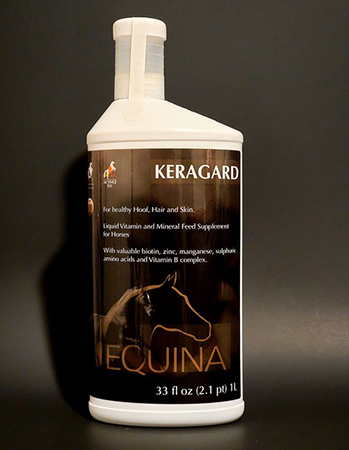 important for horses with poor hoof quality (crumbling walls,
poor infrastructure, tendency to bruise or abscess often). It is also important for horses with apparently normal feet. Nutrition affects all aspects of the
hoof including wall strength, rate of new growth, thickness and depth of the wall and sole, as well as the quality of the new growth - lending elasticity
and resilience. Many things challenge the hoof including weather, ground conditions, riding surfaces, and holding shoes. Supportive nutrition of the
feet is a powerful tool for promoting soundness and ease of management in all types of horses. (Photo # 6 Keragard) important for horses with poor hoof quality (crumbling walls,
poor infrastructure, tendency to bruise or abscess often). It is also important for horses with apparently normal feet. Nutrition affects all aspects of the
hoof including wall strength, rate of new growth, thickness and depth of the wall and sole, as well as the quality of the new growth - lending elasticity
and resilience. Many things challenge the hoof including weather, ground conditions, riding surfaces, and holding shoes. Supportive nutrition of the
feet is a powerful tool for promoting soundness and ease of management in all types of horses. (Photo # 6 Keragard)
Equina USA is a veterinarian-owned company that is dedicated to providing
the highest quality nutrition for horses. With a focus on accurate formulations and clean sourcing, the products are guaranteed to be absorbed by the
horse and produce visible results. There is a system that starts with fulfilling basic daily requirements of vitamins, minerals, and trace elements backed
with yeast and algae for added nutrients, omega 3’s and digestive aid. With basic needs fulfilled, a platform is created to build upon for each individual
horse based on the age and activities as well as any physical goals or challenges. Keragard is a hoof supplement designed to optimize hoof quality
in all individuals who have their basic nutrient requirements met. Keragard is unique in that it is a liquid, which is the most absorbable form of biotin which
builds a higher quality hoof. Amino acids and organic sulphurs support growth while zinc creates strength and durability. Importantly, vitamin B
complex and manganese are added to optimize metabolism of the nutrients. The end result is a stronger hoof with more resilience for barefoot horses
and a better capacity to hold a shoe for shod horses. This will eliminate the tendency for bruising and abscessing and increase overall soundness.
|